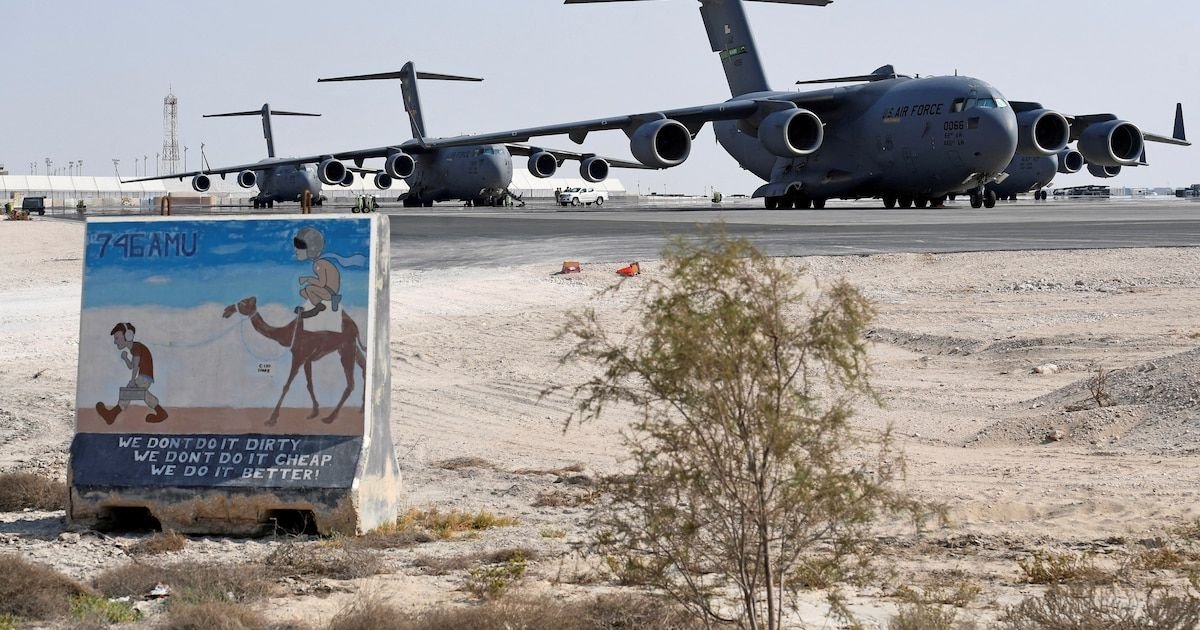INTERNACIONAL
Cómo es Al Udeid, la mayor base militar estadounidense en Medio Oriente

Irán lanzó misiles este lunes contra una base militar de EEUU en Qatar en represalia por los bombardeos estadounidenses a instalaciones nucleares iraníes. El gobierno Qatarí condenó el ataque contra la base aérea Al Udeid, afirmó que logró interceptar todos los proyectiles sin reportar víctimas y aseguró además que su espacio aéreo ya fue restablecido.
Ubicada a unos 32 kilómetros al suroeste de Doha, Al Udeid es la mayor instalación militar de Estados Unidos en Medio Oriente. Su superficie supera los 31 kilómetros cuadrados y cuenta con dos pistas de 3.650 metros de largo, capaces de recibir los aviones más pesados del arsenal aéreo estadounidense. Fue construida en 1996 con fondos qataríes y expandida tras los atentados del 11 de septiembre de 2001.
Antes del ataque iraní, imágenes satelitales mostraron la salida de cerca de 40 aeronaves estadounidenses del complejo, en medio de las tensiones regionales por los ataques israelíes contra objetivos iraníes. Para el 19 de junio, solo tres aeronaves permanecían en la base.
Al Udeid alberga al Centro Combinado de Operaciones Aéreas del Comando Central de Estados Unidos (Centcom), desde donde se coordinan misiones que cubren un extenso territorio que va desde Egipto hasta Asia Central. También funciona como sede operativa de la Real Fuerza Aérea británica (RAF) en el Golfo.

En la base se han desplegado regularmente aviones de combate F-15 Eagle, bombarderos estratégicos B-52 Stratofortress, aviones cisterna KC-135 Stratotanker, transportes C-17 Globemaster III, C-130 Hercules y plataformas de inteligencia como el RC-135 Rivet Joint.
Al Udeid ha sido un eje de operaciones estadounidenses en conflictos recientes. Desde allí se coordinaron las campañas aéreas en Irak y Siria, los ataques con drones en Yemen y las misiones de apoyo logístico en Afganistán. En 2021, jugó un rol crucial durante la evacuación de Kabul tras la toma del poder por parte de los talibanes.
La base cuenta con infraestructura defensiva avanzada, incluyendo baterías de misiles Patriot, refugios reforzados para aeronaves, amplias reservas de combustible y sistemas de radar de largo alcance. Estas defensas fueron claves para la interceptación del ataque iraní.
Según el Ministerio de Defensa qatarí, todos los misiles fueron interceptados con éxito y no se registraron daños materiales ni bajas. Irán afirmó que lanzó un número de misiles equivalente al de bombas lanzadas por EEUU en sus instalaciones nucleares, y que eligió Al Udeid como blanco por su ubicación fuera de zonas urbanas.

Fuentes diplomáticas citadas por medios internacionales indicaron que Irán podría haber advertido previamente a Qatar sobre el ataque, buscando evitar una escalada directa con el país anfitrión y con Washington. Esto sugiere un intento deliberado de limitar el impacto del ataque.
Qatar ha invertido más de 8.000 millones de dólares en el mantenimiento y modernización de Al Udeid. Recientemente, destinó unos 1.400 millones a mejorar las instalaciones de alojamiento y pistas aéreas. A cambio, EEUU mantiene una presencia militar estable en su territorio.
Además del alojamiento de tropas, Qatar ha fortalecido sus capacidades militares mediante la compra de armamento estadounidense, como ocho drones MQ-9B Predator por un valor cercano a los 2.000 millones de dólares. Estas adquisiciones refuerzan su vigilancia y capacidad de respuesta.
La base en Qatar forma parte de una arquitectura de defensa conjunta con Bahrein, donde se encuentra la sede de la Quinta Flota de EEUU. Mientras Bahrein ejerce control naval en el Estrecho de Ormuz, Al Udeid facilita la proyección aérea y el reabastecimiento de largo alcance.

(Europa Press/Contacto/U.S. National Guard)
El acuerdo de permanencia de Al Udeid fue renovado recientemente por una década más. Durante las negociaciones, legisladores estadounidenses condicionaron su apoyo a demandas sobre la postura de Qatar respecto a grupos terroristas como Hamas y Hezbollah, que son respaldados por Irán.
La presencia estadounidense en Al Udeid también genera beneficios económicos en EEUU. La compra de aviones F-15 por parte de Qatar a Boeing ha generado decenas de miles de empleos en la industria aeronáutica estadounidense.
Al Udeid es más que una base aérea: es el centro operativo clave de EEUU en Medio Oriente. Su valor estratégico, capacidades técnicas y significado diplomático la convierten en un activo central en un momento de creciente tensión regional.
Diplomacy / Foreign Policy,Middle East,Civil Unrest,Doha
INTERNACIONAL
Rusia bombardeó una prisión y atacó zonas civiles en el sureste de Ucrania: hay al menos 20 muertos y 40 heridos

Un ataque aéreo ruso sobre una prisión en la región ucraniana de Zaporizhzhia dejó 16 muertos y 35 heridos, según informó este lunes Ivan Fedorov, jefe de la administración militar local. El bombardeo fue parte de una serie de ocho ataques rusos en la región, que también causaron daños estructurales a la prisión y destruyeron viviendas cercanas.
“Las instalaciones fueron completamente destruidas y las casas en los alrededores también sufrieron daños”, escribió Fedorov en Telegram. El ataque se suma a otros registrados esa misma noche en el país. En la región de Dnipropetrovsk, un misil impactó en la ciudad de Kamyanske, provocando la muerte de dos personas, hiriendo a otras cinco y afectando un hospital, según Sergiy Lysak, jefe de la administración regional.
En el distrito de Synelnykivsky, una persona falleció y varias resultaron heridas tras otro ataque. Además, en la localidad de Velykomykhaylivska, una mujer de 75 años murió y un hombre de 68 fue herido tras el impacto sobre una vivienda privada.
En el sur de Rusia, las autoridades informaron de una ofensiva ucraniana con drones. “Un coche fue alcanzado en la calle Ostrovsky. El conductor murió”, declaró Yuri Slyusar, gobernador interino de la región de Rostov.
Los ataques coinciden con una nueva fase de la ofensiva rusa, que ha logrado avanzar en zonas que hasta ahora estaban menos expuestas desde el inicio de la invasión en 2022. Durante el fin de semana, el ejército ruso aseguró haber “liberado el asentamiento de Maliyevka”, en Dnipropetrovsk, poco después de haber tomado el control de otra aldea en esa misma región. Kiev, sin embargo, ha desmentido la consolidación de esos avances en el terreno.
El bombardeo contra la prisión se produce también en un momento de presión internacional. El presidente estadounidense Donald Trump anunció este lunes un plazo de “unos 10 o 12 días” para que Moscú ponga fin al conflicto, advirtiendo que de no hacerlo enfrentará nuevas y más severas sanciones.
El presidente de Ucrania, Volodimir Zelensky, condenó el ataque y afirmó que fue una acción deliberada contra civiles. “Fue un ataque intencional, no accidental. Los rusos no podían ignorar que estaban apuntando a una instalación con personas detenidas”, declaró en sus redes sociales. “Rusia debe ser obligada a detener los asesinatos y hacer la paz”, agregó.
El responsable de derechos humanos de Ucrania, Dmytro Lubinets, calificó el ataque como una violación directa del derecho internacional humanitario. “Las personas en centros de detención no pierden su derecho a la vida y a la protección”, señaló. Lubinets advirtió que este nuevo bombardeo refuerza las evidencias de crímenes de guerra cometidos por Rusia.
Además del ataque a la prisión, la fuerza aérea ucraniana informó que Rusia lanzó esa misma noche 37 drones y dos misiles. De ellos, 32 drones fueron interceptados, aunque algunos lograron penetrar las defensas y causar daños.
El jefe de gabinete de la presidencia ucraniana, Andriy Yermak, también se pronunció sobre el ataque. “El régimen de Putin, que lanza amenazas incluso contra Estados Unidos, debe recibir golpes económicos y militares que le impidan seguir librando esta guerra”, escribió en redes sociales.
Este bombardeo se produce casi tres años después del ataque contra un centro de detención en el territorio ocupado de Donetsk, en el este de Ucrania, donde murieron decenas de prisioneros de guerra. Aquella ofensiva, ocurrida en la noche del 29 de julio de 2022, fue atribuida por Kiev a las fuerzas rusas, aunque el Kremlin culpó a Ucrania.
La guerra en Ucrania entra en su cuarto año sin señales de un cese próximo del conflicto.

Los bombardeos a objetivos civiles continúan generando alarma internacional, mientras aumentan los llamados a Moscú para una retirada. Entretanto, Kiev intenta resistir los avances rusos y preservar su infraestructura crítica bajo constantes ataques.
(Con información de AFP)
Europe,Military Conflicts,ZAPORIZHZHIA REGION
INTERNACIONAL
El campo de concentración femenino que desafió el olvido

“Una mujer con un absceso dental murió de septicemia en pocos días”. Así lo documentó Germaine Tillion, etnóloga y prisionera en Ravensbrück, quien, durante su cautiverio, recopiló datos sobre la vida y la muerte en el campo, ocultando su investigación bajo la apariencia de recetas de cocina. Este tipo de detalles, recogidos en notas dispersas entre compañeras de confianza, se convirtieron en pruebas fundamentales para los juicios posteriores contra los responsables nazis. La historia de cómo un pequeño grupo de francesas sobrevivió, resistió y luchó por el reconocimiento de su sufrimiento en el único campo de concentración exclusivamente femenino del Tercer Reich es el eje de The Sisterhood of Ravensbrück (“La Hermandad de Ravensbrück”), el libro de Lynne Olson.
La obra de Olson se distingue por centrar su atención en las resistentes francesas que llegaron a Ravensbrück a partir de 1942. A diferencia de investigaciones previas, como la de Sarah Helm, que abarcó el conjunto del campo y se benefició de la apertura de archivos tras la caída del Telón de Acero, Olson sigue el recorrido de estas mujeres desde su arresto y deportación hasta su papel activo en la búsqueda de justicia y reparación tras la guerra. El relato se apoya en la reconstrucción de sus estrategias de supervivencia y resistencia, así como en la forma en que, una vez liberadas, articularon una campaña coordinada para que el mundo reconociera la magnitud de lo vivido.

Ravensbrück, situado a 80 kilómetros al norte de Berlín, fue diseñado para albergar a 3.000 mujeres, pero llegó a concentrar a más de 45.000 prisioneras: judías, romaníes y otras personas consideradas enemigas por el régimen nazi. Las condiciones eran extremas: una sola letrina para cada 200 internas, atención médica que solía resultar letal y enfermedades menores que se convertían rápidamente en sentencias de muerte. En seis años, alrededor de 40.000 mujeres murieron por hambre, enfermedad, tortura, experimentos médicos y, desde diciembre de 1944, por la acción de una cámara de gas instalada apresuradamente cuando los nazis calcularon que no lograrían exterminar a todas las prisioneras mediante el trabajo forzado en la fábrica Siemens cercana.
La credibilidad de los testimonios sobre Ravensbrück siempre estuvo en entredicho, como subraya Olson en su libro. El campo fue liberado tarde, lo que permitió a las SS destruir gran parte de la documentación incriminatoria. Además, la ausencia de imágenes —ningún camarógrafo acompañó al ejército soviético cuando abrió las puertas el 30 de abril de 1945— dificultó que el horror de Ravensbrück quedara grabado en la memoria colectiva, a diferencia de lo ocurrido con Auschwitz o Dachau. Esta falta de pruebas visuales y documentales complicó la tarea de las supervivientes, que debieron encontrar formas alternativas de registrar y transmitir su experiencia.

Las resistentes francesas, clasificadas por los nazis bajo el decreto Nacht und Nebel (“noche y niebla”), estaban destinadas a desaparecer sin dejar rastro. Olson describe cómo estas mujeres supieron aprovechar esa condición ambigua para organizar redes clandestinas dentro del campo: se desplazaban entre barracones durante la noche para repartir medicinas, transmitían mensajes a través de las tuberías y promovían huelgas en las fábricas de municiones. Su actitud, marcada por una “insolencia gala”, les permitió desafiar a los guardianes alemanes sin revelar nunca el alcance de su desafío.
La dificultad para ser creídas tras la liberación llevó a figuras como Tillion a documentar meticulosamente lo ocurrido. Tras la guerra, Tillion publicó su obra fundamental, Ravensbrück, en 1946, ampliándola con nuevas fuentes hasta la edición definitiva de 1988. Sin embargo, ninguna editorial francesa quiso asumir la publicación inicial, que finalmente apareció bajo un sello suizo, reflejo de la resistencia de Francia a confrontar su propio pasado de colaboración y ocupación.

Frente a este olvido deliberado, las supervivientes fundaron la Asociación Nacional de Antiguas Deportadas y Prisioneras de la Resistencia (ADIR), desde la que reclamaron vivienda, atención médica y empleo para las exinternas. Según el periódico inglés The Guardian, la fase de lucha colectiva por el reconocimiento y la justicia constituye el desenlace más potente del libro de Olson. El mayor reto de la ADIR fue lograr que los responsables de Ravensbrück comparecieran ante la justicia: de 38 acusados, 19 fueron ejecutados y el resto recibió penas de prisión o fue absuelto. La falta de pruebas escritas seguía siendo el principal obstáculo, ya que los testimonios orales, por convincentes que resultaran, podían ser descartados como “rumores” por los abogados defensores.
La persistencia de las resistentes francesas resultó decisiva en casos como el del excomandante Fritz Suhren, arrestado en 1950 mientras trabajaba como camarero en una cervecería de Berlín. En ese proceso, por primera vez, se admitieron las notas originales de Tillion, quien demostró que Suhren había firmado la orden de ejecución de 500 mujeres el 6 de abril de 1945. El 12 de junio de 1950, Suhren fue fusilado.
INTERNACIONAL
Bondi DOJ files complaint alleging misconduct by Federal Judge James Boasberg

NEWYou can now listen to Fox News articles!
The Department of Justice has filed an official complaint alleging misconduct by US District Court Chief Judge James Boasberg. Fox News has reviewed the complaint which was written by Attorney General Pam Bondi’s Chief of Staff Chad Mizelle and addressed to the Chief Judge of the United States Court of Appeals for the District of Columbia Circuit, Sri Srinivasan.
Fox News has learned that the complaint was written and filed at the direction of Attorney General Pam Bondi.
WHO IS JAMES BOASBERG, THE US JUDGE AT THE CENTER OF TRUMP’S DEPORTATION EFFORTS?
«The Department of Justice respectfully submits this complaint alleging misconduct by U.S. District Court Chief Judge James E. Boasberg for making improper public comments about President Donald J. Trump to the Chief Justice of the United States and other federal judges that have undermined the integrity and impartiality of the judiciary,» says Mr. Mizelle.
Judge Boasberg is presiding over a high-profile case involving the deportation of several migrants to El Salvador and has talked about holding DOJ lawyers in contempt because of his assertion that his order to turn airborne planes around was not followed. President Trump has also made critical comments about Judge Boasberg.
The Justice Department, headed by Attorney General Pam Bondi, has filed an official complaint regarding US District Court Chief Judge James Boasberg. (Getty Images)
The complaint details two occasions on which Judge Boasberg made comments the Justice Department alleges undermine the integrity and impartiality of the judiciary.
«On March 11, 2025, Judge Boasberg attended a session of the Judicial Conference of the United States, which exists to discuss administrative matters like budgets, security, and facilities. While there, Judge Boasberg attempted to improperly influence Chief Justice Roberts and roughly two dozen other federal judges by straying from the traditional topics to express his belief that the Trump Administration would «disregard rulings of federal courts» and trigger «a constitutional crisis.» Although his comments would be inappropriate even if they had some basis, they were even worse because Judge Boasberg had no basis—the Trump Administration has always complied with all court orders. Nor did Judge Boasberg identify any purported violations of court orders to justify his unprecedented predictions.»
TRUMP FOE BOASBERG ORDERS DOJ TO DETAIL STATUS OF CECOT MIGRANTS SENT TO VENEZUELA

This is the second time the Bondi DOJ has filed a complaint against a federal judge. (AP Photo/Mark Schiefelbein)
«Within days of those statements, Judge Boasberg began acting on his preconceived belief that the Trump Administration would not follow court orders. First, although he lacked authority to do so, he issued a temporary restraining order preventing the Government from removing violent Tren de Aragua terrorists, which the Supreme Court summarily vacated.
«Taken together, Judge Boasberg’s words and deeds violate Canons of the Code of Conduct for United States Judges, and, erode public confidence in judicial neutrality, and warrant a formal investigation.»
JUDGE BOASBERG ORDERS RUBIO TO REFER TRUMP OFFICIALS’ SIGNAL MESSAGES TO DOJ TO ENSURE PRESERVATION

The complaint details two occasions during which Boasberg allegedly made comments undermining the judiciary’s integrity and impartiality. (DREW ANGERER/AFP via Getty Images)
The DOJ is asking Chief Judge Srinivasan to refer the complaint to a special investigative committee as an inquiry is essential to determine whether Judge Boasberg’s conduct constitutes «conduct prejudicial to the effective and expeditious administration of the business of the courts.» The complaint also asks that Judge Boasberg be taken off the case involving Venezuelan migrants who were deported to El Salvador, «to prevent further erosion of public confidence while the investigation proceeds.»
The case in question is J.G.G. v Trump.
This is the second time the Bondi DOJ has filed an official complaint against a federal judge. In late February, the DOJ filed a complaint about US District Judge Ana Reyes, concerning what the DOJ calls Judge Reyes’ «misconduct» during the proceedings in Nicolas Talbott et al. v. Donald J. Trump et al., which is a case brought by two LGBTQ groups challenging the Trump Administration’s Executive Orders barring transgender individuals from serving in the US military.
News of the complaint comes at a time when the Trump administration has excoriated dozens of so-called «activist» judges who have blocked or paused some of Trump’s sweeping executive orders from taking force in his second White House term.
Judge Boasberg in particular found himself at the center of Trump’s ire and attacks on so-called «activist» judges this year, following his March 15 temporary restraining order that sought to block Trump’s use of the Alien Enemies Act to quickly deport hundreds of Venezuelan nationals to El Salvador.
Boasberg had ordered all planes bound for El Salvador to be «immediately» returned to U.S. soil, which did not happen.
WHO IS JAMES BOASBERG, THE US JUDGE AT THE CENTER OF TRUMP’S DEPORTATION EFFORTS?

WASHINGTON, DC- Judge James E. Boasberg, chief judge of the Federal District Court in DC, stands for a portrait at E. Barrett Prettyman Federal Courthouse in Washington, DC on March 16, 2023. (Photo by Carolyn Van Houten/The Washington Post via Getty Images) (Washington Post via Getty)
His emergency order touched off a complex legal saga that ultimately spawned dozens of federal court challenges across the country – though the one brought before his court on March 15 was the very first – and later prompted the Supreme Court to rule, on two separate occasions, that the hurried removals had violated migrants’ due process protections under the U.S. Constitution.
Boasberg, as a result, emerged as the man at the center of the legal fallout.
Trump administration officials have repeatedly excoriated Boasberg both for his order and his attempt to determine whether they acted in good faith to comply with his orders, and Trump himself has floated the idea that Boasberg could be impeached earlier this year – prompting Supreme Court Chief Justice John Roberts to issue a rare public warning.
The complaint, focused on months-old behavior and allegations surrounding Judge Boasberg— first tapped as a judge by then-President George W. Bush in 2002, comes at a time when he could again have a say in a major class action case brought by lawyers representing the former CECOT migrants.
Lawyers for the ACLU and others in the class asked Judge Boasberg earlier this month to reopen discovery in the case, citing allegations from a United Nations report regarding custodial status of migrants at CECOT, and the recent decision to remove the 252 migrants sent from the U.S. to El Salvador to Venezuela under the prisoner exchange.
Asked at a status hearing in court last week whether the Justice Department would comply with the court’s orders, DOJ lawyer Tiberius Davis said they would, «if it was a lawful order.»
They also said they would likely seek an appeal from a higher court.
In April, Judge Boasberg also ruled that the court had found «probable cause» to hold the Trump administration in contempt for failing to return the planes to U.S. soil, in accordance with his March 15 emergency order, and said the court had determined that the Trump administration demonstrated a «willful disregard» for his order.
CLICK HERE TO GET THE FOX NEWS APP
The U.S. Court of Appeals for the D.C. Circuit stayed his original motion in April, and has yet to move on the matter.




































